Jack Russell Terrier
(Russell Terrier) (Rebel Terrier)
Photo Courtesy of Three Mile Jacks.
| Pronunciation | Jack Russell Terrier |
Description | A sturdy, tough terrier, very much on its toes all the time. The body length must be in proportion to the height, and it should present a compact, balanced image, always being in solid, hard condition. The head should be well balanced and in proportion to the body. The skull should be flat, of moderate width at the ears, narrowing to the eyes. There should be a defined stop, which is the transition area from backskull to muzzle, but not overpronounced. The length of the muzzle from the nose to the stop should be slightly shorter than the distance from the stop to the occiput. The nose should be black. The jaw should be powerful and well boned with strongly muscled cheeks. Eyes Should be almond shaped, dark in color and full of life and intelligence. The ears are small "V" shaped drop ears carried forward close to the head and of moderate thickness. Mouth Strong teeth with the top slightly overlapping the lower. Two bites are acceptable; level and scissor - scissor being preferred. The neck is clean and muscular, of good length, gradually widening at the shoulders. The shoulders should be sloping and well laid back, fine at points and clearly cut at the withers. Forelegs should be strong and straight boned with joints in correct alignment. Elbows hanging perpendicular to the body and working free of the sides. The chest should be shallow, narrow and the front legs not too widely apart, giving an athletic, rather than heavily chested appearance. As a guide only, the chest should be small enough to be easily spanned behind the shoulders, by average sized hands, when the terrier is in a fit, working condition. The back should be strong, straight and, in comparison to the height of the terrier, give a balanced image. The loin should be slightly arched. The hindquarters should be strong and muscular, well put together with good angulation and bend of stifle, giving plenty of drive and propulsion. Looking from behind, the hocks must be straight. The feet are round, hard padded, wide, of cat-like appearance, neither turning in nor out. The tail should be set rather high, carried gaily and in proportion to body length, usually about four inches long, providing a good hand-hold. The coat is smooth, without being so sparse as not to provide a certain amount of protection from the elements and undergrowth. Rough or broken coated, without being woolly. Colors, white should predominate (i.e., must be more than 51% white) with tan, black, or brown markings. Brindle markings are unacceptable. Gait movement should be free, lively, well coordinated with straight action in front and behind. Old scars or injuries, the result of work or accident, should not be allowed to prejudice a terrier's chance in the show ring unless they interfere with its movement or with its utility for work or stud. An Irish-type called Jack Russell Shortys have shorter legs than the English-type. |
| Temperament | The Jack Russell Terrier is a cheerful, merry, devoted, and loving dog. Spirited and obedient, yet absolutely fearless. Careful and amusing, he enjoys games and playing with toys. Stable Jack's are friendly and generally kind to children. Children should be taught not to tease or hit the dog. They are intelligent, and if you let them take an inch, they can become willful and determined to take a mile. It is paramount that you are this dogs pack leader. He needs to be given rules to follow, and limitations as to what he is and is not allowed to do. Do not let this little dog fall into Small Dog Syndrome, where he believes he is pack leader to all humans. This is where varying degrees of behavior problems will arise, including, but not limited to guarding, snapping, separation anxiety, and obsessive barking. They are highly trainable, able to perform impressive tricks. They have been used on TV and in the movies. However, if you do not show authority towards the dog , they can be difficult to train. They need a firm, experienced trainer. Jacks who have been allowed to take over can be aggressive with other dogs. Some have killed or been killed in dog fights. Be sure to socialize the Jack. They have strong hunting instincts (stronger than your average terrier) and should not be trusted with other small animals. This hunting dog likes to chase, explore, bark and dig. Only let them off lead if they are well trained or in a safe area. Will get restless and destructive if they do not receive enough exercise and activities to occupy their keen minds. Jack Russells climb, which means they can climb over a fence, they also jump. A Jack that stands 12 inches high can easily jump five feet. JRTs are not the breed for a inexperienced dog owner. The owner needs to be as strong-willed as they are, or this little guy will take over. With the right owner the Jack can really excel, but is not recommended for those who do not understand what it means to be a dogs true pack leader. Jacks who are mentally stable, with all of their canine instincts met, will not display these negative behaviors. They are not traits of the Jack Russell, but rather human brought on behaviors, which are a result of inefficient leadership, along with a lack of mental and physical stimulation. They will thrive with a job to do. The Jack Russell Terrier must present a lively, active and alert appearance. It should impress with its fearless and happy disposition. It should be remembered that the Jack Russell is a working terrier and should retain these instincts. Nervousness, cowardice or over-aggressiveness should be discouraged and it should always appear confident. |
| Height, Weight | Height: 10-15 inches (25-38 cm) Weight: 14-18 pounds (6-8 kg) |
| Health Problems | Some are prone to dislocation of the kneecaps, inherited eye diseases, deafness, Legg Perthes-a disease of the hip joints of small breeds of dogs. |
| Living Conditions | The Jack Russell Terrierwill do okay in an apartment if they are sufficiently exercised. They are very active indoors and will do best with at least an average-sized yard. |
| Exercise | The Jack Russell Terrier is a pleasant companion when it is sufficiently exercised; however if they do not get enough, they may become a nuisance. They need to be taken on a long, daily, brisk walk. In addition, he will be in his glory with space to run, hunt and play. If the Jack is left alone during the day be it in an appartment or a house, they should be well exercised before the human leaves for work by taking them on a long pack walk or jog, and then taken out again when they return home. |
| Life Expectancy | About 15 or more years. |
| Grooming | All coat types are easy to groom. Comb and brush regularly with a firm bristle brush, and bathe only when necessary. To show, owners must strip the coat. Like the rough coat, the broken coated Jack needs to be stripped out also. |
| Origin | The breed was named after a clergyman named Rev. John Russell. They were used as a small game hunting dog particularly for red fox, digging the quarry out of its den in the mid-1800s. On English hunts, the dogs needed to be long-legged enough to keep up with the hounds. Breeders had emphasized its working ability, so the standard was very broad, allowing a wide range of accepted body types. Not happy with this wide variety of working type Jacks, as of April 1st 2003 the Jack Russell Terrier Association of America, was changed to the Parson Russell Terrier Association of America. The working types remained Jack Russels while the American show types became known as the Parson Russell Terrier. Some of the Jack Russell's talents include: hunting, tracking, agility, and performing tricks. |
| Group | Terrier |
Recognition | JRTCA, FCI, UKC, KCGB, NZKC, CET, ANKC, IKC, CKC, NKC, APRI, ACR, DRA FCI, ANKC, IKC, recognize the shorts as Jack Russell Terriers and the UKC recognized the shorts as Russell Terriers. The Parsons are the long legged Jack Russell Terriers named officially Parsons Russell Terriers. The Jack Russell Terrier and the Russell Terrier are the same breed but are entirely a separate breed from the Parsons Russell Terrier. The Irish Kennel Club has recognized the Jack Russell Terrier in Ireland adopting the FCI standard for the breed. At one time the AKC recognized the Jack Russel Terrier, however as of April 1st 2003 they changed the name to Parson Russel Terrier. The breed split into two breeds and now the Jack Russell Terriers and Parson Russell Terriers are considered two different breeds. The Parson's name change is in great part to a lawsuit from the JRTCA to the AKC, when the breed was first allowed registration. |
-------------------------------------------------------------------------------------
Maltese
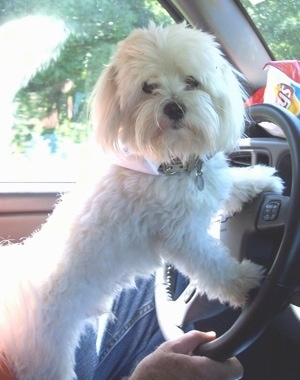
"Maltese named Prince- better known as NutPup at 3 years old. "Keep your eyes on the road, NutPup.""
| Pronunciation | Mall-TESE |
| Description | The Maltese is a small, hardy dog with silky hair. The body is compact, fine-boned, but sturdy and slightly longer than it is tall with a level top line. The chest is deep. The skull is slightly rounded on the top with a moderate stop. The medium length muzzle tapers, but not to a point. The pendant, low-set ears are set close to the head and heavily feathered. The black eyes are large, round and set moderately apart with dark rims. The nose is black with open nostrils. The dog has a silky, single layer coat that is white or light ivory. When kept long and groomed like a show dog, it hangs flat, long over the sides of the body almost to the ground (about 8½ inches (22cm.)) hanging on each side of a center part line and is not wavy, curly or kinky. A lot of owners choose to cut the coat into a short, easy care puppy cut. |
| Temperament | The Maltese is spirited, lively and playful. Gentle, loving, trusting and devoted to its master. Highly intelligent. Good at learning tricks. Bold and quick to sound the alarm in case of suspicious noises. It is a classical companion dog; graceful and lovable. They do well with other non-canine animals and other dogs. Maltese love to play outdoors. Some like to jump in puddles. May be difficult to housebreak. If you feed them table scraps, they can become picky eaters. Do not allow these dogs to develop Small Dog Syndrome, human induced behaviors, where the dog believes he is pack leader to humans. This causes a varying degree of behavior problems. If the dog believes he is boss, he can be snappish with children and even adults. Do not over-pamper or overprotect these little dogs, for they will become unstable, and some may become jealous of visitors. Maltese who are allowed to take over the house, being boss of the humans can also develop separation anxiety, guarding, and obsessive barking. These are not Maltese traits, but rather behaviors brought on by the way the dog is treated by the people around them. These behaviors will go away when the dog is surrounded by stable pack leaders. |
| Height, Weight | Height: Dogs 8-10 inches (21-25cm.) Bitches 8-9 inches (20-23cm.) Weight: from 6½-9 pounds (3-4kg.) |
| Health Problems | Prone to sunburn along the hair parting; skin, eye issues, respiratory, and slipped stifle. Some may be difficult to feed with weak, upset digestion. They may get the chills, and they experience discomfort in hot weather. Maltese should be kept out of damp areas. Also prone to teeth problems. Feeding dry dog biscuits in addition to their normal food can help the teeth stay clean and healthy. |
| Living Conditions | The Maltese is a good dog for apartment life. They are very active indoors and will do okay without a yard. |
| Exercise | Maltese need a daily walk. Play will take care of a lot of their exercise needs, however, as with all breeds, play will not fulfill their primal instinct to walk. Dogs who do not get to go on daily walks are more likely to display behavior problems. They will also enjoy a good romp in a safe open area off lead, such as a large fenced in yard. They remain playful well into old age. They are very active indoors. |
| Life Expectancy | About 15 or more years. It may live as long as 18, but it is important to keep it out of the damp. |
| Grooming | Daily combing and brushing of the long coat is important but be gentle, as the coat is very soft. Clean the eyes daily to prevent staining, and clean the beard after meals for the same reason. Bathe or dry shampoo regularly - making sure the animal is thoroughly dry and warm afterward. Clean the ears, and pull out hair growing inside the ear canal. The eyes should be checked regularly and cleaned if necessary. The hair on the top of the head is often tied up in a topknot to keep it away from the eyes. Some pet owners opt to clip the hair short for easier and less time consuming grooming. The Maltese sheds little to no hair and is good for allergy sufferers. |
| Origin | The Maltese was developed in Italy. It is said to have miniature spaniel and poodle blood. The Maltese was first recognized as a breed in Malta, where they received their name. They were once known as "Ye ancient dogge of Malta,". The breed was owned by royalty all over the world. Women carried them around in their sleeves and slept with them in their beds. They were first brought to England by Crusaders returning home from the Mediterranean. The Maltese was first recognized by the AKC in 1888. |
| Group | Gun Dog, AKC Toy |
| Recognition | CKC, FCI, AKC, UKC, KCGB, CKC, ANKC, NKC, NZKC, APRI, ACR, DRA |
(Nihon Supittsu)
Corey, Kia and Kismet, three beautiful Japanese Spitz from Australia. Photo Courtesy of Kiraleea Japanese Spitz.
| Description | The long-haired coat of the Japanese Spitz has a thick under-layer that is always pure white. The tail is covered with long hair and is carried curled over the back. The coat is short on the bottom half of the legs, with breeches on the hind legs and feathering on the forelegs. The ears are small and pointed upright, and the muzzle tapers slightly. The large oval eyes are dark and slightly slanted, and the nose and lips are black. The face of the Japanese Spitz is wedge-shaped. There is dense feathering on the feet. |
| Temperament | The Japanese Spitz is a high-spirited, intelligent, and playful dog, which is alert and obedient. This bold little dog is a good watchdog and will alert its owners when it feels it is necessary. The Japanese Spitz is not difficult to train as long as the owner is always consistent. This breed learns quickly and really enjoys agility and playing games of catch with balls or Frisbees. This happy dog is usually good with children and usually gets along well with other dogs and household pets. The Japanese Spitz is, in spirit, a big dog in a little dog's body. This tough little dog acts as a house protector and guardian. The Japanese Spitz can be an inveterate barker if you allow them to believe they are in charge. Be sure to tell your dog enough is enough and to quiet down if he starts barking obsessively. Cheerful, bold, proud and affectionate toward its masters. Make sure you are this dog's firm, confident, consistent pack leader to avoid Small Dog Syndrome, human induced behavior problems. When dogs are allowed to be pack leader to humans they can developed many types of behavior issues, including, but not limited to, being suspicious of and barking at strangers, guarding, separation anxiety, destructiveness, snapping, and even biting. These are not Spitz traits, but rather behaviors resulting in a lack of leadership on the humans part. Always remember, dogs are canines, not humans. Be sure to meet their natural instincts as animals. They need rules to follow, limits to what they are and are not allowed to do and a firm, consistent, confident pack leader, along with daily mental and physical exercise. |
| Height, Weight | Height: 12-15 inches (30-38 cm.) Weight: 11-20 pounds (5-10 kg.) |
| Health Problems | - |
| Living Conditions | The Japanese Spitz is good for apartment life. This breed is fairly active indoors and will do okay without a yard as long as it gets plenty of outings and exercise. |
| Exercise | This is a busy little dog who will adapt himself to your lifestyle so long as you take the dog for a long, daily walk. In addition, they will enjoy a regular chances to run off its lead in a safe area. |
| Life Expectancy | About 12 years. |
| Grooming | The Japanese Spitz should be combed and brushed regularly. This is a very tidy animal that should be bathed only when necessary. When the dog is shedding, use a comb with a double row of metal teeth to remove loose hairs from the under-layer. |
| Origin | No one knows for sure of the origins of the Japanese Spitz, but some claim it is descended from the native Siberian Samoyed. This theory is controversial but those who believe it claim, Samoyeds were strictly bred for smallness, with the end result being the Japanese Spitz. Everything about the Japanese Spitz strongly suggests that it is simply a small version of the Samoyed. Creation of the breed commenced in the late 1800s. Very popular in Japan in the 1950s, and although numbers in the native land have declined, it has become increasingly popular in Europe and North America. |
| Group | Northern |
| Recognition | FCI, KCGB, NKC, CKC, ANKC, APRI, ACR, DRA |




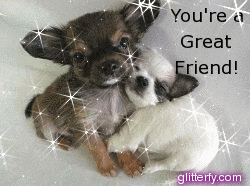




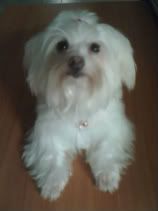


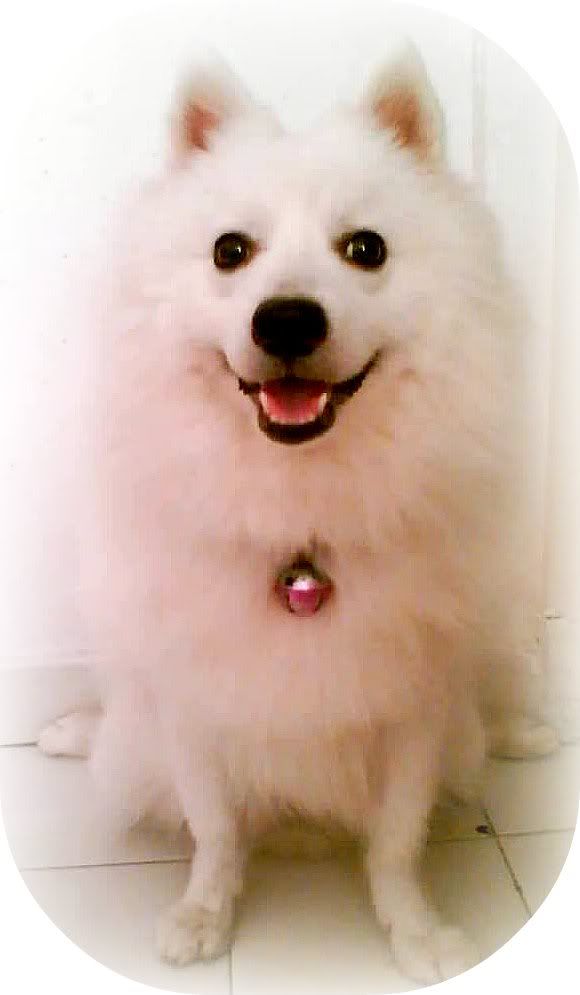


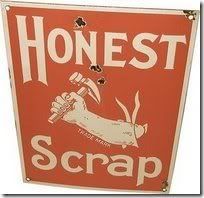

























 Glitterfy.com - Glitter Graphics
Glitterfy.com - Glitter Graphics
No comments:
Post a Comment